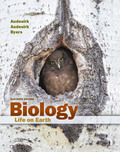
Concept explainers
Which of the following statements about protists is False?
a. Some protists are photosynthetic.
b. All protists are eukaryotes.
c. Although protists are diverse, they form a single clade.
d. Protists include both unicellular and multicellular species.
Introduction:
Bacteria, archaea, and eukaryotes are the three domains of life. The eukaryotes consist of plant, animals, and fungi. However, there are certain eukaryotes that do not fall in these three groups. They are collectively known as protists.
Answer to Problem 1MC
Correct answer:
The false statement from the given statements is that although the protists are diverse, they form a single clade.
Explanation of Solution
Explanation for the correct answer:
Option (c) is given that, although protists are diverse, they form a single clade is false about protists. A clade can be defined as a group consists of all the decedents of a particular common ancestor. The protists do not have a common ancestor. All the protists are not even related. Protist is a term coined by systematics to help them catalog the organisms that do not fall in specific eukaryotes types. Thus, the protists do not form a single clade. Hence, option (c) is a correct answer.
Explanation for the incorrect answers:
Option (a) is given that some protists are photosynthetic is false about protists. However, protists gain nutrition by different processes like nutrient absorption from the surroundings, ingestion of food, and capturing solar energy through the process of photosynthesis. The example of photosynthetic protist is Caulerpa. So, it is an incorrect option.
Option (b) is given that all protists are eukaryotes, is false about protists. Of the life’s three domains, only bacteria and archaea are prokaryotes. All protists are eukaryotes; however, they do not fall in plant, animal, or fungi categories. So, it is an incorrect option.
Option (d) is given that protists include both unicellular and multicellular species is false about protists. Most of the protists are unicellular and so, they are usually invisible; however, there are some multicellular protists that are physiologically and structurally complex. So, it is an incorrect option.
Hence, options (a), (b), and (d) are incorrect.
Therefore, it can be concluded that although the protists are diverse, they do not form a single clade. This is because they do not have a single ancestor.
Want to see more full solutions like this?
Chapter 21 Solutions
EBK BIOLOGY
- Which of the following protist exhibit the discoid type of mitochondrial cristae? A. trypanosoms B. diatoms C. oomycete D. brown algaearrow_forwardWhat feature of protists allow them to survive harshenvironmental conditions?a. vegetative cellsb. planktonc. cystsd. plastidse. vacuolesarrow_forwardWhat genus of protists appears to contradict the statement that unicellularity restricts cell size? a. Dictyostelium b. Ulva c. Plasmodium d. Caulerpaarrow_forward
- Which of the following explains why protists are considered a paraphyletic group? A Protists are prokaryotic. B Protists cannot be a monophyletic group because their morphology and behavior are so variable. C Protists lack a common ancestor. O D The MRCA of the protists also gave rise to plants, animals, and fungi. O E Choices B and D are both correct.arrow_forwardWhich of the following is NOT a characteristic of all protists?a. Unicellularb. Cells containing membrane-bounded organellesc. Cells containing a nucleusd. Eukaryoticarrow_forwardWhich of the following can be associated with life cycles in protists? Select all that apply. A. alternation of generations B. multicellular haploids and unicellular diploids C. heterotrophic diploids and phototrophic haploids D. meiosis and fertilization E. binary fission F. zygotes producing gametesarrow_forward
- Identify from the list below the protists that function almost like multicellular organisms when food is depleted, forming a multicellular mass that forms fruiting bodies. A. slime molds B. oomycetes C. cercozoans D. diatomsarrow_forwardIdentify from the list below the protists that possess two flagella, are unicellular and common members of the phytoplankton A. diatoms B. dinoflagellates C. forams D. parabasalidsarrow_forwardSlime molds/moulds or mycetozoans is a broad term that applies to many fungus-like protists. a. In what sense is it appropriate to describe slime molds as “fungus animal”? b. Elaborate on the evolution of the slime molds into two distinct groups.arrow_forward
- which of the statements is not true regarding protist? a. they may have cell walls b. They may be photosynthetic c. they may be prokaryotic d. they are usually aerobic though some are not e. some are unicellulararrow_forwardWhich of the following representative protists is NOT correctly matched with respect to their locomotion? I. Paramecium:cilia IV. Dinoflagellate: flagella II. Euglena: flagella V. Vorticella: pseudopodia III. Amoeba: sporozoa 2.Effective work with the viruses depended upon the development of the A. light microscope B. ultraviolet light microscope C. dark-field microscope D. electron microscopearrow_forwardChoose the best below ? All protists are a. photosynthetic.b. parasites.c. single-celled.d. eukaryotes.e. All of these are correct.arrow_forward

 Concepts of BiologyBiologyISBN:9781938168116Author:Samantha Fowler, Rebecca Roush, James WisePublisher:OpenStax College
Concepts of BiologyBiologyISBN:9781938168116Author:Samantha Fowler, Rebecca Roush, James WisePublisher:OpenStax College Biology (MindTap Course List)BiologyISBN:9781337392938Author:Eldra Solomon, Charles Martin, Diana W. Martin, Linda R. BergPublisher:Cengage Learning
Biology (MindTap Course List)BiologyISBN:9781337392938Author:Eldra Solomon, Charles Martin, Diana W. Martin, Linda R. BergPublisher:Cengage Learning


